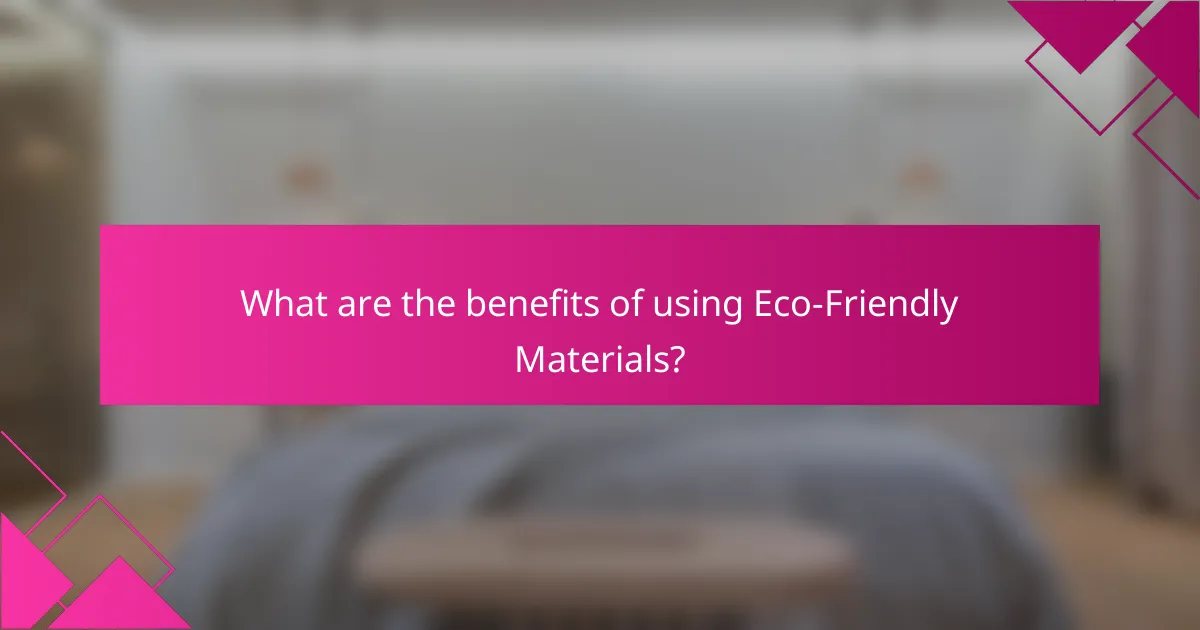Eco-friendly materials are substances that minimize environmental impact, often being sustainable and biodegradable. This article explores various types of eco-friendly materials, such as bamboo, recycled plastics, and organic cotton, highlighting their benefits, including reduced carbon footprints and enhanced indoor air quality. It discusses how these materials can be integrated into design practices, promoting energy efficiency and sustainability while supporting a circular economy. The adoption of eco-friendly materials not only contributes to environmental conservation but also fosters healthier living spaces and communities.

What are Eco-Friendly Materials?
Eco-friendly materials are substances that have a minimal impact on the environment. They are often sustainable and biodegradable. Common examples include bamboo, recycled plastics, and organic cotton. These materials reduce waste and pollution. They are sourced responsibly to ensure conservation of natural resources. Eco-friendly materials often have lower carbon footprints compared to conventional options. Using them can lead to healthier living spaces. Their adoption supports a circular economy, promoting recycling and reuse.
How are eco-friendly materials defined?
Eco-friendly materials are defined as substances that have minimal impact on the environment. They are often derived from renewable resources. These materials can be biodegradable or recyclable. Additionally, they typically produce less waste during their lifecycle. Eco-friendly materials aim to reduce pollution and conserve natural resources. For example, bamboo is a rapidly renewable resource that can be used in various applications. According to the U.S. Environmental Protection Agency, using eco-friendly materials can significantly decrease environmental harm. This definition aligns with sustainable practices in manufacturing and construction.
What characteristics make materials eco-friendly?
Eco-friendly materials possess characteristics that minimize environmental impact. They are often made from renewable resources, reducing reliance on finite materials. Biodegradability is another key trait; these materials break down naturally, preventing pollution. Low toxicity is crucial, as eco-friendly materials should not release harmful substances during use or disposal. Energy-efficient production processes further enhance their sustainability. Recyclability allows materials to be reused, reducing waste. Finally, eco-friendly materials often support sustainable practices, promoting responsible sourcing and manufacturing.
Why is the use of eco-friendly materials important?
The use of eco-friendly materials is important because they reduce environmental impact. These materials minimize pollution during production and disposal. They often come from renewable resources, promoting sustainability. Eco-friendly materials can also improve indoor air quality. Studies show that using such materials can lead to better health outcomes. For instance, low-VOC (volatile organic compounds) paints reduce harmful emissions. Additionally, eco-friendly materials can enhance energy efficiency. Buildings made with these materials often require less energy for heating and cooling. Overall, their use supports a healthier planet and society.
What types of eco-friendly materials exist?
Eco-friendly materials include bamboo, recycled plastics, organic cotton, hemp, cork, and reclaimed wood. Bamboo is a fast-growing plant that requires minimal resources. Recycled plastics help reduce waste and conserve energy. Organic cotton is grown without harmful pesticides and fertilizers. Hemp is a durable fiber that grows quickly and enriches the soil. Cork is harvested from the bark of cork oak trees, allowing for regrowth. Reclaimed wood repurposes old timber, reducing deforestation and waste. These materials contribute to sustainability by minimizing environmental impact.
What are natural materials and their benefits?
Natural materials are substances derived from nature, including wood, stone, cotton, and wool. They are biodegradable and non-toxic, making them environmentally friendly. Natural materials offer numerous benefits. They provide better indoor air quality compared to synthetic alternatives. They are often more durable, reducing the need for frequent replacements. Natural materials can also have lower energy consumption in production. For example, bamboo grows rapidly and requires minimal resources, making it a sustainable choice. Additionally, they often have aesthetic qualities that enhance design and comfort.
How do recycled materials contribute to sustainability?
Recycled materials contribute to sustainability by reducing waste and conserving resources. They help minimize landfill use, which is crucial for environmental health. The recycling process saves energy compared to producing new materials. For example, recycling aluminum saves up to 95% of the energy needed to create new aluminum from ore. Additionally, using recycled materials decreases the demand for virgin resources, preserving natural habitats. According to the Environmental Protection Agency, recycling and composting prevented the release of 186 million metric tons of carbon dioxide equivalent into the air in 2018. This demonstrates the significant impact of recycling on reducing greenhouse gas emissions.
What innovative eco-friendly materials are emerging?
Innovative eco-friendly materials emerging include mycelium, hempcrete, and recycled ocean plastics. Mycelium is a biodegradable material derived from fungi. It serves as a sustainable alternative to traditional packaging and building materials. Hempcrete is made from hemp fibers and lime. This material is known for its insulation properties and carbon sequestration capabilities. Recycled ocean plastics are repurposed waste collected from oceans. They are used in various products, including textiles and construction materials. These materials contribute to sustainability efforts by reducing waste and minimizing environmental impact.

What are the benefits of using Eco-Friendly Materials?
Eco-friendly materials offer numerous benefits that positively impact the environment and human health. They reduce carbon footprint by minimizing the use of non-renewable resources. These materials often require less energy to produce, resulting in lower greenhouse gas emissions. Using eco-friendly materials can lead to improved air quality, as they typically contain fewer volatile organic compounds (VOCs). Additionally, they promote sustainability by being biodegradable or recyclable, thus reducing landfill waste. Research shows that buildings made with eco-friendly materials can enhance occupant well-being through better indoor air quality. Overall, the adoption of eco-friendly materials contributes to a healthier planet and community.
How do eco-friendly materials impact the environment?
Eco-friendly materials positively impact the environment by reducing pollution and conserving resources. These materials often come from renewable sources, minimizing the depletion of natural resources. Their production typically generates lower greenhouse gas emissions compared to conventional materials. For example, bamboo grows rapidly and absorbs carbon dioxide, making it a sustainable choice. Additionally, eco-friendly materials often have biodegradable properties. This reduces landfill waste and pollution when disposed of. Studies show that using recycled materials can save energy and reduce the need for new raw materials. Overall, eco-friendly materials contribute to a healthier ecosystem and promote sustainable practices.
What are the long-term environmental benefits?
Long-term environmental benefits include reduced pollution, conservation of resources, and enhanced biodiversity. Eco-friendly materials often generate less waste during production. This leads to lower emissions of harmful substances into the air and water. Additionally, using sustainable materials helps preserve natural resources for future generations. For example, bamboo grows rapidly and requires minimal water compared to traditional timber. This contributes to forest conservation and reduces deforestation rates. Moreover, eco-friendly materials can improve soil health and promote ecosystem resilience. Studies show that sustainable practices can lead to a 30% reduction in carbon footprint over time. These benefits collectively support a healthier planet.
How do they reduce carbon footprint?
They reduce carbon footprint by using sustainable materials and practices. Eco-friendly materials often require less energy to produce. For example, bamboo grows rapidly and absorbs carbon dioxide during its growth. Recycled materials reduce the need for new resources, thereby lowering emissions. Implementing energy-efficient manufacturing processes also minimizes greenhouse gas output. Additionally, local sourcing of materials decreases transportation emissions. These strategies collectively contribute to a significant reduction in overall carbon footprint.
What economic advantages do eco-friendly materials offer?
Eco-friendly materials offer significant economic advantages, including cost savings and market demand. They often reduce energy consumption during production, leading to lower operational costs. For instance, using recycled materials can decrease manufacturing expenses by up to 30%. Additionally, eco-friendly products can attract a growing consumer base that prioritizes sustainability. Research indicates that 66% of global consumers are willing to pay more for sustainable brands. Companies adopting eco-friendly materials may also benefit from government incentives and tax breaks. These factors contribute to long-term profitability and competitive advantage in the market.
How can businesses save costs using eco-friendly materials?
Businesses can save costs using eco-friendly materials by reducing waste and energy consumption. Eco-friendly materials often have lower production costs due to their sustainable sourcing. For example, recycled materials can be cheaper than virgin materials. Additionally, using these materials can lead to lower disposal costs. Many eco-friendly materials also enhance energy efficiency in production processes. Companies may receive tax incentives for using sustainable materials. Furthermore, eco-friendly practices can improve brand reputation, leading to increased sales. Studies show that companies adopting sustainable practices can see a reduction in operational costs by up to 30%.
What market trends are driving the demand for eco-friendly materials?
Increasing consumer awareness and demand for sustainability are driving the market for eco-friendly materials. Consumers are increasingly prioritizing environmentally responsible products. This shift is evident in various sectors, including fashion, construction, and packaging. The global sustainable materials market was valued at approximately $1 trillion in 2020 and is projected to grow significantly. Regulations and policies promoting sustainability also contribute to this trend. Governments are implementing stricter environmental standards, encouraging companies to adopt eco-friendly practices. Additionally, innovations in technology are making sustainable materials more accessible and affordable. As a result, businesses are responding to these trends by integrating eco-friendly materials into their offerings.

How can Eco-Friendly Materials be integrated into design?
Eco-friendly materials can be integrated into design through various methods. Designers can choose sustainable materials such as bamboo, recycled plastics, or organic fabrics. These materials reduce environmental impact and promote sustainability. Incorporating them in architectural design enhances energy efficiency and reduces waste. Utilizing local materials also minimizes transportation emissions. Designers can adopt practices like upcycling to create new products from discarded items. Furthermore, employing eco-friendly finishes and adhesives ensures a lower toxic footprint. Research shows that using sustainable materials can significantly lower carbon emissions in construction. Integrating these materials aligns with growing consumer demand for environmentally responsible products.
What design principles support the use of eco-friendly materials?
Sustainable design principles support the use of eco-friendly materials. These principles focus on minimizing environmental impact. They promote the use of renewable resources. Lifecycle assessment is a key factor in evaluating materials. This assessment considers the environmental effects from production to disposal. Modular design encourages reusability and adaptability of materials. Energy efficiency is prioritized in the selection of materials. The principle of reducing waste supports the use of eco-friendly options. Additionally, biophilic design enhances connection to nature through material choices.
How can designers prioritize sustainability in their projects?
Designers can prioritize sustainability in their projects by selecting eco-friendly materials. This includes using recycled, renewable, or biodegradable resources. They can also implement energy-efficient design practices to reduce resource consumption. Designers should consider the entire lifecycle of materials, from production to disposal. Incorporating local materials can minimize transportation emissions. Engaging in sustainable sourcing practices ensures responsible procurement. Additionally, designers can utilize digital tools for efficient resource management. Research indicates that sustainable design can reduce environmental impact significantly, with studies showing a 30% decrease in carbon footprint when eco-friendly materials are used.
What are the challenges of integrating eco-friendly materials into design?
Integrating eco-friendly materials into design presents several challenges. One challenge is the higher cost of sourcing sustainable materials. Traditional materials often have lower price points due to established supply chains. Another challenge is the limited availability of eco-friendly options in certain regions. This can restrict designers from accessing diverse materials. Compatibility with existing manufacturing processes is also an issue. Eco-friendly materials may require specialized techniques that are not widely adopted. Performance and durability can be a concern as well. Some sustainable materials may not meet the same standards as conventional options. Additionally, consumer perception can pose a challenge. There may be misconceptions about the quality and aesthetics of eco-friendly materials. Finally, regulatory hurdles can complicate the integration process. Compliance with environmental standards can add complexity to design projects.
What are some successful examples of eco-friendly design?
Some successful examples of eco-friendly design include the Bosco Verticale in Milan and the Eden Project in the UK. Bosco Verticale features residential towers covered in trees and plants. This design improves air quality and promotes biodiversity. The Eden Project consists of biomes housing diverse plant species. It utilizes renewable energy and sustainable materials. Another example is the Bullitt Center in Seattle. It is designed to be energy-positive, generating more energy than it consumes. These projects exemplify innovative approaches to sustainability in architecture.
How have brands effectively used eco-friendly materials?
Brands have effectively used eco-friendly materials by incorporating sustainable practices into their production processes. For example, companies like Patagonia use recycled polyester in their clothing lines. This reduces waste and minimizes the use of virgin materials. IKEA has committed to using sustainable wood sources for its furniture, ensuring responsible forestry practices. Furthermore, Nike has introduced shoes made from recycled materials, showcasing innovation in design while promoting sustainability. According to a 2021 report by McKinsey, 67% of consumers prefer brands that are environmentally friendly. This consumer preference drives brands to adopt eco-friendly materials. Brands that prioritize sustainability often see increased customer loyalty and market share.
What lessons can be learned from these examples?
Lessons learned from these examples include the importance of sustainability in material selection. Eco-friendly materials reduce environmental impact significantly. They often provide health benefits by minimizing toxins. Additionally, integrating these materials can enhance design aesthetics. Successful case studies show increased consumer interest in sustainable products. Companies adopting eco-friendly practices often see improved brand loyalty. These examples highlight the potential for innovation in sustainable design. Overall, the shift toward eco-friendly materials is both a market opportunity and a necessity.
What practical tips can be applied for using eco-friendly materials in design?
Use sustainable materials such as bamboo, recycled metal, and reclaimed wood in design. These materials minimize environmental impact and reduce waste. Choose locally sourced materials to lower carbon footprints associated with transportation. Opt for non-toxic finishes and adhesives to ensure indoor air quality. Incorporate modular designs that allow for easy disassembly and reuse of components. Prioritize durability to extend the lifespan of products and reduce the need for replacements. Educate clients and stakeholders about the benefits of eco-friendly materials to promote sustainable choices. Implement a life cycle assessment to evaluate the environmental impact of materials used in design.
Eco-friendly materials are substances that have minimal environmental impact, often derived from renewable resources and designed to be biodegradable or recyclable. This article explores the various types of eco-friendly materials, such as bamboo, recycled plastics, and organic cotton, and highlights their benefits, including reduced pollution and improved indoor air quality. It also examines how these materials can be integrated into design practices, emphasizing sustainable design principles and the economic advantages they offer. Additionally, the article addresses the challenges of using eco-friendly materials while providing practical tips for their effective implementation in design projects.


